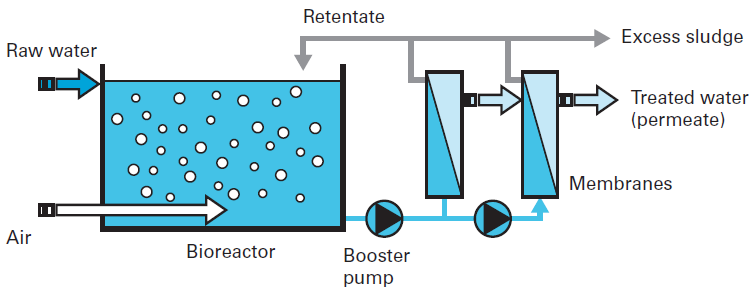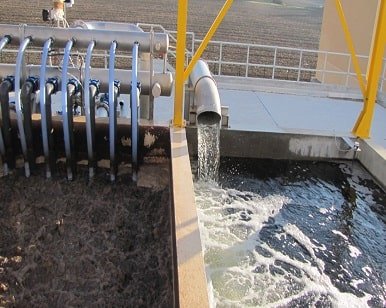Future Trends in Membrane Bioreactor Technology and Its Global Impact
Membrane Bioreactors Explained: Effective Solutions for Tidy Water
Membrane layer bioreactors (MBRs) have actually become a sophisticated option for addressing journalism difficulties of wastewater treatment. By incorporating organic procedures with innovative membrane filtering, MBRs not only boost the top quality of cured water yet likewise minimize the spatial needs of therapy centers. As ecological problems magnify, the function of MBR innovation in advertising lasting water administration ends up being progressively considerable. Nonetheless, the complexities of their operation, advantages, and possible applications warrant a closer assessment to completely comprehend their effect on the future of water treatment.

What Are Membrane Layer Bioreactors?
Membrane bioreactors (MBRs) are innovative wastewater therapy systems that integrate biological destruction procedures with membrane purification innovation. This combination enables the reliable removal of impurities from water, making MBRs a favored choice in numerous applications, including metropolitan wastewater treatment and commercial effluent administration.

One of the critical benefits of MBRs is their capacity to create top quality effluent, often ideal for reuse in irrigation or commercial processes. In addition, MBRs require a smaller sized footprint contrasted to conventional therapy systems, making them perfect for urban settings where area might be limited.
In addition, MBRs can successfully handle varying influent lots and are less at risk to the effects of hazardous shocks. These features add to their growing appeal as a sustainable remedy for dealing with the raising demand for clean water while decreasing environmental effects.
Just How Membrane Bioreactors Work
While the procedure of membrane layer bioreactors (MBRs) may appear complicated, it basically revolves around the synergy between organic procedures and membrane layer purification. MBRs incorporate a biological treatment procedure, generally triggered sludge, with a membrane layer splitting up unit to treat wastewater effectively.
In an MBR system, wastewater is very first presented right into a bioreactor where microorganisms deteriorate organic matter and various other impurities. The organic task reduces the concentration of pollutants while promoting the growth of biomass. Following this biological treatment, the mixed liquor goes through membrane filtering, which can be microfiltration or ultrafiltration, depending upon the preferred effluent high quality.
The membrane layers function as a physical obstacle, enabling water and little solutes to pass while preserving suspended solids and bigger particles. This makes it possible for the system to preserve a high concentration of biomass within the activator, boosting the therapy effectiveness.
In addition, the constant separation of treated water from the biomass helps with a small design and minimizes the impact of the therapy center. Overall, the combination of organic degradation and membrane layer filtering in MBRs results in trustworthy and reliable wastewater treatment, guaranteeing premium effluent suitable for various applications.
Benefits of MBR Innovation
One of the key advantages of membrane layer bioreactor (MBR) innovation is its ability to generate top notch effluent with a significantly lowered footprint compared to standard wastewater treatment methods. MBR systems successfully integrate organic treatment and membrane filtering, resulting in premium removal of contaminants, consisting of suspended solids, virus, and raw material. This ability leads to effluent that usually satisfies or goes beyond rigorous governing criteria for reuse and discharge.
In addition, MBR modern technology permits greater biomass focus, which enhances the therapy effectiveness and minimizes the needed activator quantity. This compact style is specifically helpful in urban locations where space is limited. The functional adaptability of MBR systems likewise suggests they can adapt to differing influent top qualities and flow rates, making them ideal for a variety of applications.
Moreover, the decreased sludge Related Site manufacturing connected with MBR processes contributes to reduce functional and upkeep costs. The membranes function as a physical obstacle, minimizing the risk of blocking and allowing longer functional durations between cleaning. In general, the benefits of MBR modern technology make it an attractive remedy for sustainable wastewater treatment, dealing with both ecological problems and the requirement for effective resource administration.
Applications of Membrane Layer Bioreactors
With their convenience and performance, membrane layer bioreactors (MBRs) find applications across various markets, including community wastewater treatment, industrial procedures, and also water reclamation. In local settings, MBRs offer a compact remedy for dealing with wastewater, efficiently getting rid of pollutants while all at once creating top quality effluent that meets rigid regulatory criteria. This makes them particularly suitable for locations with minimal space.
In commercial applications, MBR innovation is used for treating process water, particularly in industries such as food and beverage, pharmaceuticals, and petrochemicals. These markets take advantage of MBRs' ability to handle high natural tons and their effectiveness in recovering beneficial sources from wastewater, such as nutrients and water.
Furthermore, MBRs play an important role in water reclamation campaigns, allowing the reuse of treated wastewater for watering, industrial procedures, or also as potable water after further therapy (Membrane Bioreactor). Their efficiency in getting rid of microorganisms and pollutants makes them a trusted option for making certain water quality in numerous reuse applications
Future of Water Therapy Solutions
The future of water treatment options is poised for transformative improvements driven by technological development and raising environmental recognition. As international water shortage ends up being a pressing concern, brand-new techniques, including membrane layer bioreactor (MBR) systems, are readied to play a crucial function in boosting the efficiency and sustainability of water therapy procedures.
Emerging innovations such as artificial knowledge and equipment knowing company website are anticipated to optimize treatment procedures, permitting real-time tracking and anticipating maintenance. This will certainly enhance the total integrity and efficiency of water therapy centers. Innovations in membrane layer materials, such as graphene and nanofiltration, promise to boost permeation rates and lower fouling, leading to lower energy intake and operational costs.
Additionally, the combination of sustainable energy resources right into water treatment plants will certainly add to greener practices. The circular economy model will also acquire traction, motivating the recuperation of useful sources from wastewater, such as nutrients and energy.
Final Thought

Membrane bioreactors (MBRs) have arised as an advanced service for resolving the pressing challenges of wastewater therapy. By integrating biological procedures with sophisticated membrane layer filtering, MBRs not just boost the quality of cured water however additionally decrease the spatial needs of treatment centers.One of the key benefits of internet membrane bioreactor (MBR) innovation is its capacity to produce high-grade effluent with a substantially reduced footprint contrasted to conventional wastewater therapy approaches.With their flexibility and performance, membrane layer bioreactors (MBRs) find applications throughout various industries, consisting of municipal wastewater treatment, commercial procedures, and even water reclamation.In final thought, membrane layer bioreactors represent a significant improvement in wastewater therapy technology, integrating biological procedures with reliable membrane layer filtration to create top notch effluent.